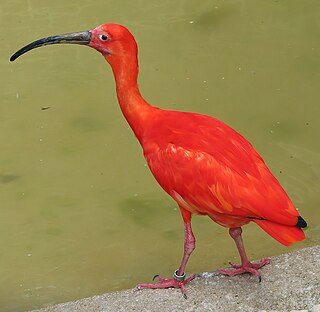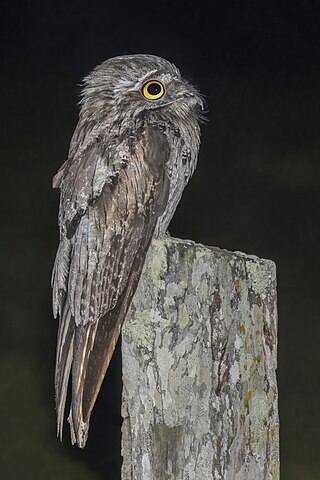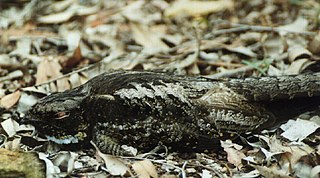
The family Threskiornithidae includes 36 species of large wading birds. The family has been traditionally classified into two subfamilies, the ibises and the spoonbills; however recent genetic studies have cast doubt on this arrangement, and have found the spoonbills to be nested within the Old World ibises, and the New World ibises as an early offshoot.

Potoos are a group of birds related to the nightjars and frogmouths. They are sometimes called poor-me-ones, after their haunting calls. The family Nyctibiidae was formerly included with the nightjars in the order Caprimulgiformes but is now placed in a separate order, Nyctibiiformes. There are seven species in two genera in tropical Central and South America. Fossil evidence indicates that they also inhabited Europe during the Paleogene.

The frogmouths (Podargidae) are a group of nocturnal birds related to owlet-nightjars, swifts, and hummingbirds. Species in the group are distributed in the Indomalayan and Australasian realms.

The pauraque – also called the common pauraque to distinguish it from similar species – is a nightjar species, one of two birds in the genus Nyctidromus. It breeds in the subtropical and tropical regions of the New World, and except for northernmost birds it is largely resident all year round.

The tawny frogmouth is a species of frogmouth native to the Australian mainland and Tasmania and found throughout. It is a big-headed, stocky bird often mistaken for an owl due to its nocturnal habits and similar colouring.

The chuck-will's-widow is a nocturnal bird of the nightjar family Caprimulgidae. It is mostly found in the southeastern United States near swamps, rocky uplands, and pine woods. It migrates to the West Indies, Central America, and northwestern South America.

The rufous fantail is a small passerine bird, most commonly known also as the black-breasted rufous-fantail or rufous-fronted fantail, which can be found in Australia, Indonesia, Micronesia, New Guinea and the Solomon Islands. In these countries they inhabit rainforests, wet forests, swamp woodlands and mangroves.
The thick-billed ground dove is an extinct dove species of the family Columbidae.

The eared nightjars are a small group of nocturnal birds in the nightjar family, although the taxonomy is uncertain. There are seven species, mainly found in forest and scrub from China to Australia. Five species are placed in the genus, Eurostopodus, the other two species in Lyncornis. They are long winged birds with plumage patterned with grey and brown to camouflage them when resting on the ground. They feed on insects caught in flight. A single white egg is laid directly on the ground and incubated by both adults. The chicks can walk soon after hatching.

Finsch's pygmy parrot, also known as the emerald pygmy parrot and green pygmy parrot, is a member of parrot family Psittacidae inhabiting tropical rainforest regions of islands in Papua New Guinea, the Solomon Islands, and the Bismarck Archipelago.

The marbled frogmouth is a bird in the family Podargidae. The species was first described by Jean René Constant Quoy and Joseph Paul Gaimard in 1830. It is found in the Aru Islands, New Guinea and Queensland. Its natural habitats are subtropical or tropical moist lowland forest and subtropical or tropical moist montane forest.

The Papuan frogmouth is a species of bird in the family Podargidae.

The black imperial pigeon, also known as the Bismarck imperial pigeon, is a species of bird in the pigeon family, Columbidae. First described by English zoologist Philip Sclater in 1878, it is endemic to the Bismarck Archipelago, where it mainly inhabits rainforest and cloud forest in mountain areas above 500 m (1,600 ft). It is a large, heavily-built imperial pigeon, with a length of 38–43 cm (15–17 in) and a weight of 661–665 g (23.3–23.5 oz). Adults are almost entirely black, except for the dark chestnut undertail coverts, the silvery-grey underside of the tail, and a pale grey scaly pattern on the wings and back. Both sexes look alike. Juveniles differ from adults in having paler undertail coverts.

The crested cuckoo-dove is a species of bird in the pigeon family, Columbidae. First described by English zoologist John Gould in 1856, it is endemic to the Solomon Islands archipelago, where it mainly inhabits hill forests at elevations of 500–900 m (1,600–3,000 ft). It is a large and robust pigeon, with a length of 40–42 cm (16–17 in) and a distinctive pale purplish-grey crest. Adults are mainly bluish-grey, with a pale greyish-buff throat, blackish tail, and yellow-tipped reddish bill. Both sexes look alike. Juveniles lack the crest, have darker heads, and have duller wings.

The Malagasy paradise flycatcher is a species of bird in the family Monarchidae. It is found in Comoros, Madagascar, and Mayotte. Its natural habitats are subtropical or tropical dry forest and subtropical or tropical moist lowland forest.
David William Steadman is a paleontologist and ornithologist, and serves as the curator of ornithology at the Florida Museum of Natural History at the University of Florida.

The spotted green pigeon or Liverpool pigeon is a species of pigeon which is most likely extinct. It was first mentioned and described in 1783 by John Latham, who had seen two specimens of unknown provenance and a drawing depicting the bird. The taxonomic relationships of the bird were long obscure, and early writers suggested many different possibilities, though the idea that it was related to the Nicobar pigeon prevailed, and it was therefore placed in the same genus, Caloenas. Today, the species is only known from a specimen kept in World Museum, Liverpool. Overlooked for much of the 20th century, it was recognised as a valid extinct species by the IUCN Red List only in 2008. It may have been native to an island somewhere in the South Pacific Ocean or the Indian Ocean, and it has been suggested that a bird referred to as titi by Tahitian islanders was this bird. In 2014, a genetic study confirmed it as a distinct species related to the Nicobar pigeon, and showed that the two were the closest relatives of the extinct dodo and Rodrigues solitaire.

Strisores, sometimes called nightbirds, is a clade of birds that includes the living families and orders Caprimulgidae, Nyctibiidae (potoos), Steatornithidae (oilbirds), Podargidae (frogmouths), Apodiformes, as well as the Aegotheliformes (owlet-nightjars) whose distinctness was only recently realized. The Apodiformes and the Aegotheliformes form the Daedalornithes.
Christopher Filardi is an American evolutionary biologist and ecologist.
















